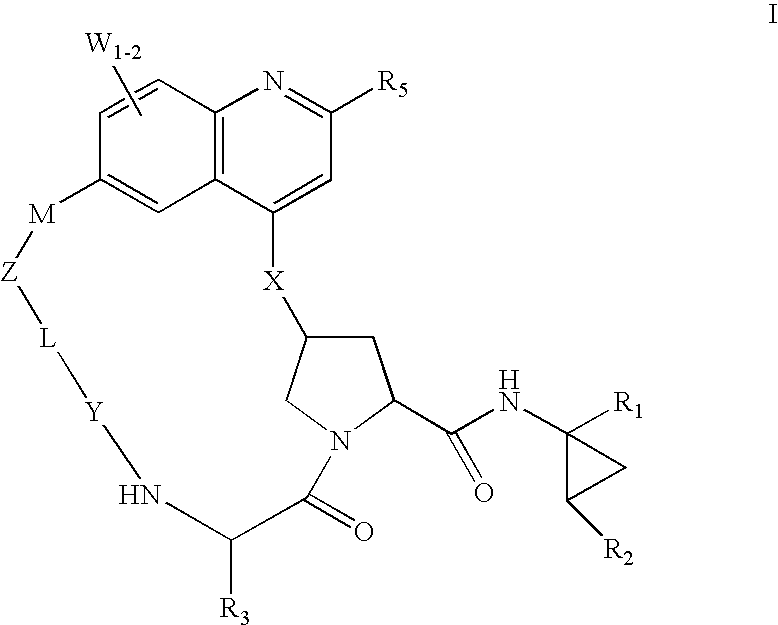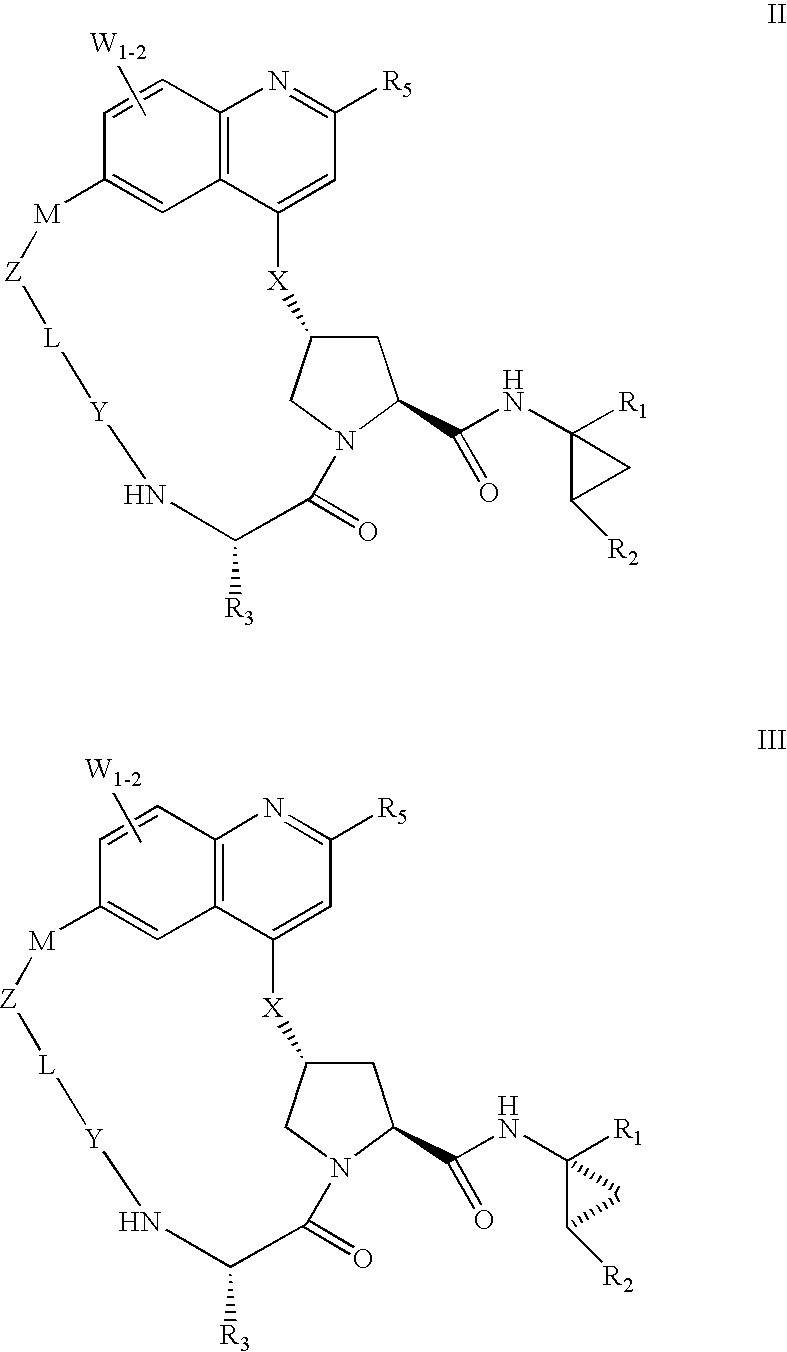HCV NS3 protease inhibitors
a protease inhibitor and hcv technology, applied in the field of macrocyclic compounds, can solve the problems of limited clinical benefit, no established vaccine for hcv, and treatment of hcv infection
- Summary
- Abstract
- Description
- Claims
- Application Information
AI Technical Summary
Benefits of technology
Problems solved by technology
Method used
Image
Examples
example 1
(1RS,2SR)-1-({[(2R,4S,7S)-7-Butyl-6,9-dioxo-18-phenyl-3,4,6,7,8,9-hexahydro-2H,11H-14,16-etheno-2,5-methanopyrido[4,3-k][1,10,3,6]dioxadiazacycloheptadecin-4-yl]carbonyl}amino)-2-vinylcyclopropanecarboxylic acid (III-1)
[0147]
Step 1: 6-Bromo-2-phenylquinolin-4(1H)-one
[0148]
[0149]A mixture of 4-bromoaniline (7.0 g, 40.7 mmol), ethyl benzoylacetate (14.09 mL, 81.4 mmol), and polyphosphoric acid (15.95 g, 162.7 mmol) was heated without solvent to 150° C. for 3 h. After 3 h, the reaction was cooled to RT, and the mixture was quenched with 4 N HCl (200 mL), which caused an orange cake to form. This solid was filtered, and to this was added 2N NaOH (200 mL). The majority of the solid did not dissolve, and was filtered off. The solid was washed with water (200 mL) and a mixture of 1:1 acetone / DCM (200 mL), and stored under vacuum overnight to give 6.52 g (53% yield) of ˜95% (by LC-MS) pure 6-bromo-2-phenylquinolin-4(1H)-one. Further purification can be accomplished by recrystallization with...
example 2
(1R,2S)-1-({[(2R,4S,7S)-7-Butyl-6,9-dioxo-18-phenyl-3,4,6,7,8,9,12,13-octahydro-2H,11H-14,16-etheno-2,5-methanopyrido[4,3-k][1,10,3,6]dioxadiazacycloheptadecin-4-yl]carbonyl}amino)-2-vinylcyclopropanecarboxylic acid (III-2)
[0163]
[0164]To a solution of 2-(trimethylsilyl)ethyl (2R,4S,7S)-7-butyl-6,9-dioxo-18-phenyl-3,4,6,7,8,9-hexahydro-2H,1H-14,16-etheno-2,5-methanopyrido[4,3-k][1,10,3,6]dioxadiazacycloheptadecine-4-carboxylate (Example 1 Step 7) (6 mg, 0.01 mmol) in EtOAc (1 mL) was added 10% Pd / C (1 mg, 0.001 mmol Pd). The flask was quickly evacuated and hydrogen gas was then introduced. This cycle was repeated three times and a balloon of H2 was left over the reaction. After 5 h, only a trace amount of unreduced starting material remained, and after 15 h, complete consumption of the starting material had occurred. The crude product was then filtered through celite with EtOAc as the eluent. The solvent was removed in vacuo and the crude material was used directly in the next reacti...
example 3
(1R,2S)-1-({[(2R,4S,7S)-7-Butyl-6,9-dioxo-20-phenyl-3,4,6,7,8,9,12,13-octahydro-2H,11H-16,18-ethanediylidene-2,5-methanopyrido[4,3-k][1,10,3,6]dioxadiazacyclononadecin-4-yl]carbonyl}amino)-2-vinylcyclopropanecarboxylic acid (III-3)
[0165]
[0166]The title compound was prepared in a manner similar to Example 1 (Steps 1-8). [(4-Pentenyloxy)carbonyl]-L-norleucine (preparation described below) was used in place of N-[(allyloxy)carbonyl]-L-norleucine. 1H NMR (500 MHz, MeOH-d4) ppm: 8.70 (s, 1H), 8.11 (m, 3H), 7.96 (m, 1H), 7.74 (m, 4H), 6.71 (d, J=15.9 Hz, 1H), 6.59 (m, 1H), 5.83 (m, 2H), 5.27 (d, 1H), 5.10 (d, 1H), 4.83 (m, 2H), 4.48 (m, 3H), 4.16 (d, 1H), 4.00 (m, 1H), 2.80 (m, 1H), 2.56 (m, 1H), 2.18 (m, 2H), 1.91 (dd, 1H), 1.90-1.63 (m, 6H), 1.50-1.40 (m, 5H), 0.95 (t, 3H). LRMS (CI, [M+H]) Calc'd=667.4. found=667.4. HRMS (APCI, [M+H]+) Calc'd for C38H43N4O7: 667.3126. found: 667.3119.
[(4-Pentenyloxy)carbonyl]-L-norleucine
[0167]
[0168]To a solution of 1-penten-4-ol (0.95 g, 11.0 mmol) in...
PUM
| Property | Measurement | Unit |
|---|---|---|
| temperature | aaaaa | aaaaa |
| volume | aaaaa | aaaaa |
| pH | aaaaa | aaaaa |
Abstract
Description
Claims
Application Information
 Login to View More
Login to View More - R&D
- Intellectual Property
- Life Sciences
- Materials
- Tech Scout
- Unparalleled Data Quality
- Higher Quality Content
- 60% Fewer Hallucinations
Browse by: Latest US Patents, China's latest patents, Technical Efficacy Thesaurus, Application Domain, Technology Topic, Popular Technical Reports.
© 2025 PatSnap. All rights reserved.Legal|Privacy policy|Modern Slavery Act Transparency Statement|Sitemap|About US| Contact US: help@patsnap.com



